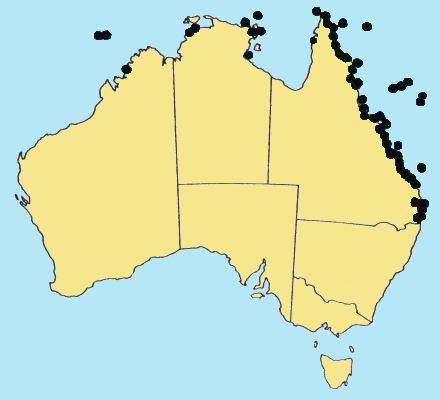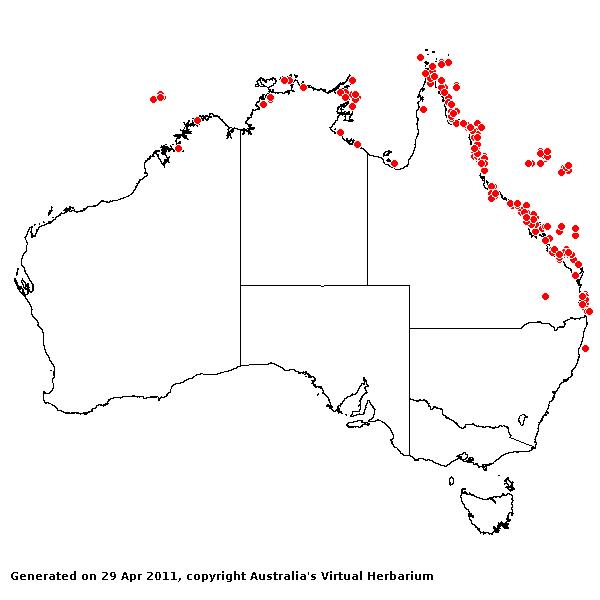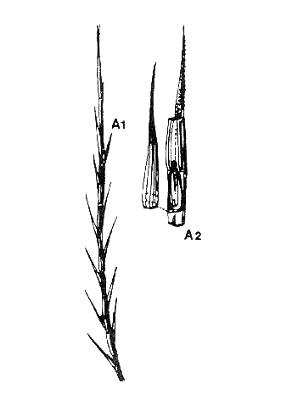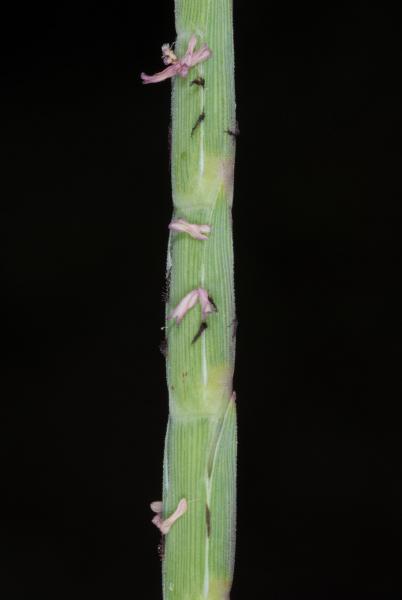Lepturus repens (Forst.) R. Br. Prodr. 207(1810).
Classification. (GPWG 2001) : Subfamily Chloridoideae. Cynodonteae.
Basionym and/or
Replacement Name: Rottboellia
repens G. Forst., Fl. Ins. Austr. 9 (1786).
Type of Basionym or
Protologue Information: Insula intra tropicos.
Key references
(books and floras): [1810]. R.Brown, Prodromus (207), [1878]
G.Bentham, Flora Australiensis 7 (668), [1969] E.E.Henty, Manual
Grasses New Guinea (121), [2002] D.Sharp & B.K.Simon, AusGrass,
Grasses of Australia, [2008] S.W.L.Jacobs, R.D.B.Walley &
D.J.B.Wheeler, Grasses of New South Wales (295).
Illustrations:
[2005] K.Mallet (ed.), Flora of Australia 44B: Poaceae 3 (Fig.
76F-G), [2008] S.W.L.Jacobs, R.D.B.Whalley & D.J.B.Wheeler, Grasses of
New South Wales, 4th edn (295).
Habit.
Perennial. Stolons present. Culms erect or geniculately ascending, 10–60 cm
tall. Ligule a fringed membrane, a ciliolate membrane. Leaf-blades linear or
lanceolate, flat or involute or convolute, 3–30 cm long, 2–10 mm wide.
Leaf-blade surface scabrous.
Inflorescence.
Inflorescence solid, a spike. Racemes 1. Rhachis fragile at the nodes.
Spikelets.
Spikelets sessile. Fertile spikelets 1 or more flowered, with 1 fertile floret,
comprising 1(–2) fertile floret(s), with a barren rachilla extension,
lanceolate, dorsally compressed, 6–14 mm long.
Glumes. Glumes
firmer than fertile lemma. Upper glume lanceolate, 6–14 mm long, cartilaginous
or coriaceous, without keels, 5–12 -nerved. Upper glume surface asperulous or
scabrous, glabrous. Upper glume apex muticous or awned.
Florets.
Fertile lemma 3.7–5.5 mm long, without keel, 3 -nerved. Lemma surface
indumented. Lemma apex entire. Palea 2 -nerved. Lodicules present. Anthers 3.
Continental
Distribution: Africa, Temperate Asia, Tropical Asia, Australasia, and
Pacific.
Australian
Distribution: Western Australia, Northern Territory, Queensland, Lord Howe,
Christmas Is, Cocos Keeling Is, Ashmore Reef, Coral Sea Is.
Western Australia:
Gardner. Northern Territory: Darwin & Gulf. Queensland: Cook,
Moreton, North Kennedy, Port Curtis, South Kennedy, Wide Bay.
Notes.
There are two subspecies.
Spikelets always solitary 3a. subsp. repens
Spikelets paired in lower or middle part of
rachis 3b. subsp. stoddartii.
Fairly
common in tropical and sub-tropical coastal areas, growing on sand, especially
coral sand, or in shallow soil on rocks; in exposed locations above the water
line, or in Casuarina woodland. Associated taxa include Thurea
involuta, Spinifex, Zoysia, Sporobolus virginicus. The
long stolons allow the formation of large, loose, green mats.
Sand binder.
Lepturus repens (G.Forst.) R.Br. subsp.
repens
Coasts of northern and eastern Australia, from
Derby in W.A. to Coffs Harbour in N.S.W, and off-shore islands. Coastal E
Africa, Southern Asia and Pacific Islands.
Lepturus repens subsp. stoddartii
Along the E coast of Qld and on off-shore
islands, from Ingram Is. in the Great Barrier Reef near Cape Melville to
Brisbane.






